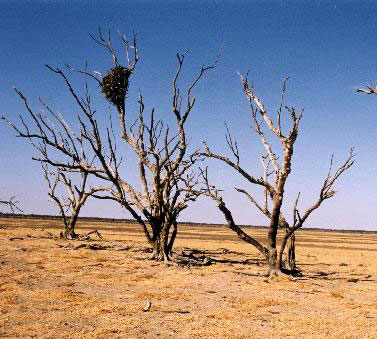Background
Beating drought: Species conservation
Managing species or populations during drought presents some unique challenges. Drought can emphatically wipe out local isolated populations of a species and this is of particular concern if the species has conservation significance. If the species is rare, or exists in only a few populations, the risk of total extinction is great if some of the populations succumb to drought, thereby further reducing genetic diversity.
In such cases, especially where general habitat management and environmental flows cannot provide sufficient protection, targeted management strategies for the population may be necessary. These might include
- transfer of threatened populations into captivity (for later re-introduction), or
- translocation of individuals from other areas once the drought has abated.
Whether or not we take such extreme protection measures is as much a social decision as a scientific one. Do we as a society wish to protect in perpetuity species endemic to a single river, such as the Cooper tandan (Neosiluroides cooperensis) - a fish that occurs only in Cooper Creek (in Queensland and South Australia)? Or are we prepared to let this and other rare species go extinct?
The above interventions carry some risk. Apart from being costly, the natural genetic structure of populations can be compromised, or diseases might be transferred between isolated populations. Where there is no other alternative, re-introduction is the better of these two ways to protect genetic diversity, so long as the risk of diseases being spread from housing facilities is considered.
Similarly, bringing in water from another catchment could rescue populations at risk of dying out due to lack of water. But again, there is potential for harm to catchments and populations that are normally isolated. Water moved across the landscape, perhaps into catchments or reservoirs that have too little water, or for a particular purpose such as topping up a metropolitan water supply, can also transfer species living in the water (such as algae, fish, invertebrates). The transfer can disrupt genetic isolation or shift unwanted introduced species (weeds and pests) or pathogens (bacterial or viral diseases) between catchments.
Screens or water treatments can counter such problems to some extent, but they are not always feasible or cost-effective.
Managing populations
Essentially, the processes involved in species conservation during drought should be consistent with the processes of developing recovery plans for endangered species. That is:
- identify all sources of threat, then
- plan actions to restore important habitats and resources so that the overall population structure of the species is maintained.
Keywords:
Topics:
| Recovery from drought | View Frequently Asked Questions | View Bibliography |
| Principels for protecting aquatic biodiversity | View Frequently Asked Questions | View Bibliography |
| Drought impacts | View Frequently Asked Questions | View Bibliography |
| Water supply | View Frequently Asked Questions | View Bibliography |

